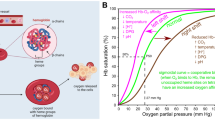Abstract
Hemerythrin is proposed as an alternative to hemoglobin-based blood substitutes. In contrast to hemoglobin, hemerythrin exhibits negligible reactivity towards oxidative and nitrosative stress agents (peroxide, nitric oxide, nitrite). Protocols for attachment of polyethylene glycol and glutaraldehyde cross-linking of Hr are described. These derivatizations appear to have favorable effects on O2 affinity and autoxidation rates for use in blood substitutes. Based on lessons learned from hemoglobin-based blood substitutes, these derivatizations should also help limit extravasation and antigenicity of a hemerythrin-based blood substitute.








Similar content being viewed by others
Abbreviations
- Hr:
-
Hemerythrin
- Hb:
-
Hemoglobin
- LB/amp:
-
Luria–Bertani/ampicillin
- OD600:
-
Optical density at 600 nm
- SDS–PAGE:
-
Sodium dodecyl sulfate–polyacrylamide gel electrophoresis
- PBS:
-
Phosphate buffer saline
- PEG:
-
Polyethelene glycol
- MS:
-
Methyl-PEG4-N-hydroxysuccinimide ester
- TMS:
-
(Methyl-PEG12)3-PEG4-N-hydroxysuccinimide ester
- DMSO:
-
Dimethylsulfoxide
- GL:
-
Gluteraldehyde
References
Alayash AI, Cashon RE (1994) Ann NY Acad Sci 738:378–381
Alayash AI (2004) Nat Rev Drug Discov 3(2):152–159
Blomberg LM, Blomberg MRA, Siegbahn PEM (2004) J Biol Inorg Chem 9:923–935
Chang TM (2004) Artif Organs 28(9):789–794
Chang TMS (2009) Crit Care Clinics 25:373–382
Cooper CE, Silaghi-Dumitrescu R, Rukengwa M, Alayash AI, Buehler PW (2008) Biochim Biophys Acta 1784(10):1415–1420
Eike JH, Palmer AF (2004) Biotechnol Prog 20(5):1543–1549
Farmer CS, Kurtz DM Jr, Phillips RS, Ai J, Sanders-Loehr J (2000) J Biol Chem 275(22):17043–17050
Farmer CS, Kurtz DM Jr, Liu ZJ, Wang BC, Rose J, Ai J, Sanders-Loehr J (2001) J Biol Inorg Chem 6(4):418–429
Giulivi C, Davies KJA (1990) J Biol Chem 265(32):19453–19460
Gladwin MT (2005) Am J Respir Cell Mol Biol 32(5):363–366
Gu J, Chang TM (2009) Artif Cells Blood Substit Immobil Biotechnol 37(2):69–77
Herold S (1998) FEBS Lett 439(1–2):85–88
Herold S, Exner M, Nauser T (2001) Biochemistry 40(11):3385–3395
Jin S, Kurtz DM Jr, Liu ZJ, Rose J, Wang BC (2002) J Am Chem Soc 124:9845–9855
Kryatov SV, Rybak-Akimova EV, Schindler S (2005) Chem Rev 105:2175–2226
Liu ZC, Chang TM (2008) Artif Cells Blood Substit Immobil Biotechnol 36(5):421–430
Nocek JM, Kurtz DM Jr, Pickering RA, Doyle MP (1984) J Biol Chem 259(20):12334–12338
Olson JS, Foley EW, Rogge C, Tsai AL, Doyle MP, Lemon DD (2004) Free Radic Biol Med 36(6):685–697
Reeder BJ, Sharpe MA, Kay AD, Kerr M, Moore K, Wilson MT (2002) Biochem Soc Trans 30(4):745–748
Reeder BJ, Svistunenko DA, Sharpe MA, Wilson MT (2002) Biochemistry 41:367–375
Reeder BJ, Svistunenko DA, Cooper CE, Wilson MT (2004) Antioxid Redox Signal 6(6):954–966
Reeder BJ, Grey M, Silaghi-Dumitrescu RL, Svistunenko DA, Bulow L, Cooper CE, Wilson MT (2008) J Biol Chem 283(45):30780–30787
Silaghi-Dumitrescu R, Silaghi-Dumitrescu I (2006) J Inorg Biochem 100(1):161–166
Tsuchida E, Sou K, Nakagawa A, Sakai H, Komatsu T, Kobayashi K (2009) Bioconjug Chem 20(8):1419–1440
Vollaard NB, Reeder BJ, Shearman JP, Menu P, Wilson MT, Cooper CE (2005) Free Radic Biol Med 39(9):1216–1228
Vollaard NB, Shearman JP, Cooper CE (2005) Sports Med 35(12):1045–1062
Winslow RM (2004) Artif Organs 28(9):800–806
Acknowledgments
We thank Prof. C.C. Cooper (University of Essex, UK) for helpful discussions. Funding from the Romanian government (project PNII 565/2007) and NIH grant GM040388 (D.M.K.) is gratefully acknowledged.
Author information
Authors and Affiliations
Corresponding author
Rights and permissions
About this article
Cite this article
Mot, A.C., Roman, A., Lupan, I. et al. Towards the Development of Hemerythrin-Based Blood Substitutes. Protein J 29, 387–393 (2010). https://doi.org/10.1007/s10930-010-9264-2
Published:
Issue Date:
DOI: https://doi.org/10.1007/s10930-010-9264-2




